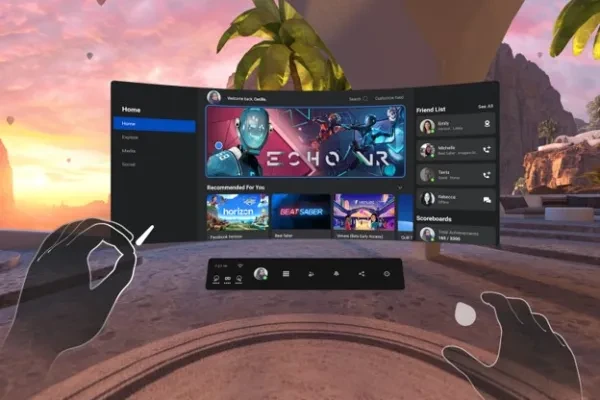
Since the Quest 2's release, Meta has put out over 50 updates that pushed the device well beyond its humble hardware. One of the most recent features is native hand tracking. Not only does this let you interact with in-game elements through your hands alone, the lack of controllers also brings in a new level of immersion that puts us one step closer to true VR. That said, here are the top Quest 2 games that best implement hand tracking:
10. Tiny Castles
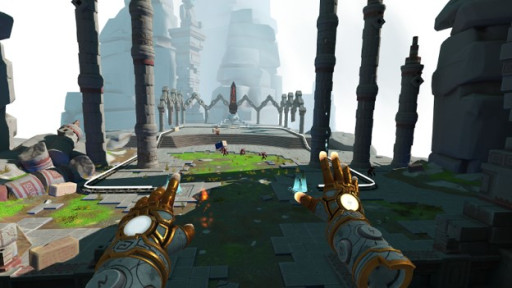
A free game to improve your hand tracking skills.
If you've played with controllers your whole life, switching to hand tracking can start off jarring. That's why we want to start things off with Tiny Castles: a free, action-puzzle game designed for a hands-only experience. So no need to shell out your hard-earned cash while you get used to a new interface.
Tiny Castles acts more as a showcase to guide you through various hand tracking mechanics. This isn't to say that the game is bad but rather, there's less focus on other factors like balancing--so expect sudden difficulty spikes. That said, it succeeds in making you feel comfortable with hands-only interactions. From pulling levers to punching baddies, you'll be ready to hide your controllers by the end of the game.
If you're starting out, we recommend trying Tiny Castle's playground mode first. This lets you play with the mechanics in an isolated sandbox so it doesn't affect your campaign. A new game puts you in the shoes of a god saving your followers from a corrupting evil. The gameplay's simple, but the silly characters, cute music, and relaxing ambience all add to a charming experience.
Play this if you like:
- Experimenting with mechanics: The nature of the game itself encourages experimentation. While it initially introduces you to the tools you can use, it slowly stops the hand holding to let you piece out what else you can do with the mechanics.
- Cute NPCs and character models: Being a god, you tower over almost any other creature in the game. Even supposed knights become tiny and cute in your hands. Plus, they have silly reactions when poking them.
- Throwing objects off the map: Don’t lie, we know you’ve done this before. Tiny Castles has many pickable objects and characters that you can pluck and throw into the horizon. Watching the models splay out from your virtual, godly strength is satisfying.
- Commanding troops: Another part of the gameplay is adding simple commands to your knights. From pushing on a pressure plate to shielding your body, you’ll have to think what the best instructions are to solve some of the included puzzles.
9. The Curious Tale of Stolen Pets

A charming puzzle game for all ages.
For a more casual experience, The Curious Tale of Stolen Pets offers fun, light puzzles that add charm to its already heartfelt story. Here, you'll revisit old memories, find missing animals, and maybe even close the growing rift between you and your sibling.
Admittedly, the puzzles aren't particularly hard. They are, however, beautiful. Levels come in the form of dioramas that you can prod and poke to generate events. You can also pick up various objects that will eventually reveal where a pet is hidden. The addition of hand tracking only makes the interaction more real, as though you're truly part of the world.
From cozy summerhouses to volcanic islands, it's apparent that each level is crafted with love and care. There might even be details that you'll miss the first time through. All in all, while short, the game makes excellent use of its playtime, easing you in a gentle experience that's perfect for a night of relaxation.
Play this if you like:
- Miniature puzzles: Most of the game revolves around finding what objects interact with what. This leads to some basic puzzle solving like figuring out how to raise a treasure chest from a giant teacup. Not the most brain-heavy process, but engaging enough for a casual night of relaxation.
- Heartwarming narratives: At its core, The Curious Tale of Stolen Pets tells the story of two siblings who've grown apart over the years. The excellent voice acting and sound design does wonders for the narrative, enhancing the emotional impact of the story.
- Hidden object games: Over five levels, you'll have to find all the missing pets. Some will be hiding in plain sight after a quick turn of the map, while others will need more sleuthing. So prepare your Where's Waldo hats because some of these pets live up to the word missing.
- Charming dioramas: The levels are all presented like tiny dioramas you can interact with. Each has their own unique theme and it's evident that all of them are crafted with care. If you enjoy looking at highly detailed sets, you'll love the presentation in The Curious Tale of Stolen Pets.
8. Guided Tai Chi

Look into the future of exercise,
With VR becoming a medium for exercise, Guided Tai Chi brings the concept forward by adding hand tracking support. The idea is simple: you follow a path with your hands, mimicking real tai chi movements. There are multiple exercises to choose from to meet your needs, whether that's to tone your muscles or just to gamify your workout.
Admittedly, it won't have you sweating as much as games like Thrill of the Fight. Tai Chi, after all, doubles as a meditative experience, with heavier focus on slow, consistent movements. However, the ability to do this without controllers is liberating, grounding you to the moment which is crucial for the tone of the game.
Guided Tai Chi is a testament to what VR can become. As good as it is now, imagine future iterations where the game world is fully manipulated with only your body. Until that time, we'll be enjoying the serene activities that Guided Tai Chi has to offer.
Play this if you like:
- Fitness games: Living up to its name, Guided Tai Chi is first and foremost a fitness game. There are no major objectives except to follow the various exercises and possibly beat your previous scores. If you like challenging yourself or simply adding physical movement to your habits, Guided Tai Chi is a great addition to your library.
- Relaxing aesthetics: As a meditative experience, Guided Tai Chi puts a lot of effort into creating a relaxing environment. The warm setting and soothing soundtrack does wonders to lose yourself in the moment and ease your mind throughout the session.
- Guided training: Over the course of an exercise, a voiceover will instruct you with supplementary actions like when to inhale and exhale. This is great if you want mentors throughout your exercise, but if you prefer working out solo, there's an option for that too.
7. Hand Physics Lab
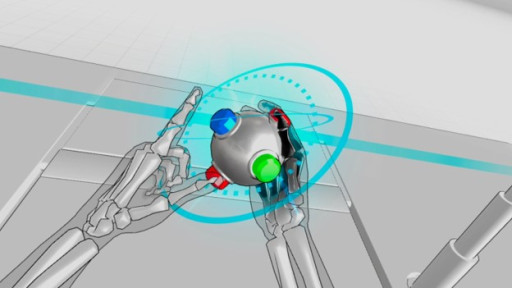
Solve puzzles with outside-the-box thinking.
With a name like Hand Physics Lab, it's no surprise that it makes excellent use of the Quest 2's hand tracking. It's essentially a sandbox that gives you full control over the world with just your fingers.
The game does offer puzzles to solve. However, these serve more as a presentation of its mechanics rather than a test to your logic skills. You'll be drawing, building towers, and throwing planets among many more fun options. With hand tracking, these all start feeling more reactive. Plus, you can pet a virtual cat!
Hand Physics Lab is a great entry point for hand tracking controls. With no difficulty barriers, you can jump right in and experiment with all the tools the game has to offer.
Play this if you like:
- Physics-based simulation: The game simulates real world physics. That means no super-powered lifts or throws. This only improves the puzzle-solving aspect, forcing you to think critically to meet objectives within the bounds of reality.
- Finding creative approaches to puzzles: With how VR works, more freedom is allowed to the player compared to flatscreen games. This lets you take on unique approaches otherwise undoable. Bad at shooting? Walk towards the hoop! Can't stop cubes from moving about? Use your in-game arms to block their path! There's usually a clear-cut way to progress, but if you want to challenge yourself with out-of-the-box thinking, Hand Physics Lab offers many opportunities.
- Unspecified objectives: After the initial levels, you're mostly left in the dark for the rest of the game. It will just spawn you in a room with various objects and leaves you to figure out how to proceed. This approach is great for players who enjoy trial and error, though, fair warning that a few levels can take you over ten minutes due to its vagueness.
- Gaming in short bursts: Most levels only take a couple of minutes to complete. If you have a limited schedule, this is great for squeezing in some game time.
6. Myst VR

Test your logic in a fantastical, atmospheric adventure.
A polished iteration of a beloved classic, Myst makes a comeback 30 years after its original release. Its VR counterpart features the same appealing setting and logic puzzles for old fans, while also being a wholly new experience through its new interface.
With hand tracking, the immersion jumps to new levels. Books are read, buttons are pushed--not just clicked with a controller. The exploration becomes sensory, pulling you into its world and bridging the divide between what's virtual and reality.
But, as with older titles, Myst fully embodies its puzzle-solving. There are no action-packed sequences, and the satisfaction comes from solving what has stumped you for hours. But all of these hint to something greater. As you continue with the story, you'll slowly piece out that what seemed like disconnected scenes are part of a cohesive whole--and the journey to that reveal is well worth the effort.
Play this if you like:
- Reading. Lots of it: Most of the game's lore is only revealed through text. In fact, reading is essential to progress as your next objective is often hidden in one of the in-game books.
- Rewarding logical puzzles: Myst throws in some difficult brain teasers, but never ones that feel unfair. There are no pixel hunts or reflex-based solutions so you'll have to fully rely on your own cognitive thinking. That said, solving a puzzle in Myst doesn't just feel rewarding, but earned.
- Slow burn games: Like the original release, Myst builds up its atmosphere and setting. While this creates some drawn out sections, the payoff is well worth it as you unravel the mysteries of how the world came to be.
- Note taking: Strictly speaking, this is an optional part of the game. However, it is recommended as you'll be thrown many clues that might not be used until later parts of the story. Fortunately, Myst VR supports an in-game journal so no need to take off the Quest 2 to jot down your thoughts.
5. Eternal Starlight
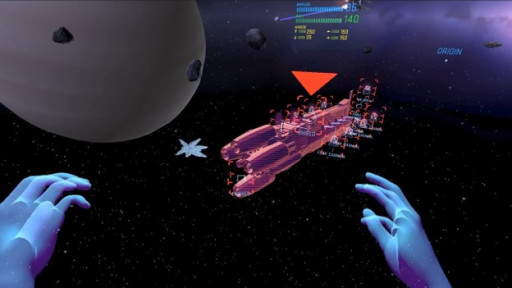
Lead your troops in tactical space combat.
Take command of your fleet and plot your course through a battle-ridden section of space. You’ll meet colorful alien species, collect powerful tech, and vaporize enemies. But be careful–you’re just as easily killed, so you’ll need all your tactical prowess to lead the way to victory.
The game utilizes an intuitive locomotion system. By default, you have a macroscopic view of the battlefield–but pinch your fingers and you can zoom in to be as up close and personal to the action as you want. This hand tracking action adds a layer of authority to your movement, truly making you feel like the commander, simulating the best course of action for your crew.
Throughout the game, positioning is key. Even with the hundreds of available ships, their unique abilities are only truly utilized if they’re in optimal position. There is risk to this, though, as moving your units can put them in the enemies’ line of sight. It’s almost like playing a spaceship version of chess, where anticipating several steps ahead is crucial to your strategy.
Play this if you like:
- Tactical space fights: The core concept of the game. While there’s no dogfighting, you’ll have to strategically place your troops, juggling between dodging enemy hits and making your own attacks.
- Meeting new species: What’s a space adventure with no alien species? Fortunately, in the game, you’ll encounter tons of different creatures, some humanoid and others …more grotesque.
- Traveling through the stars: If you love space, you’ll enjoy the backgrounds in Eternal Starlight. The bluish-black backdrop is emphasized by starlight and distant nebulas, truly making you feel small in the scale of the universe.
4. Little Cities
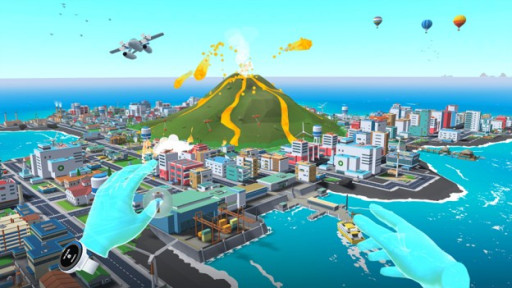
See your town come to life.
Players of Cities: Skyline will enjoy the same level of simulation and city building in Little Cities. While you start off with a humble village, you slowly build your town up into a bustling settlement. Be careful though, as you progress, you'll have to place more and more elements to keep your city afloat and residents happy.
Hand tracking is a breath of fresh air in such a tried-and-true genre. The bubble-based menus are intuitive and plopping various city tiles is as easy as pinching your fingers. More than ever, Little Cities makes you feel like an architect capable of shaping the world with a few gestures.
With recent updates adding even more elements like fauna and concession stands, the game provides more than enough tools to bring your creativity to life. Even if you're not a fan of city management, the game's visuals and mechanics are strong enough to at least warrant a try.
Play this if you like:
- Designing your own metropolis: Ever walked home and thought, "I can organize the town better than this." Well, in Little Cities, you can fully realize that dream! From road placement to store locations, your whole city is designed by your hands.
- Managing your creation: Of course, aside from making your town look neat, you have to make sure it's functional, too. That means interconnected railway systems and funding healthcare buildings among others. All this can be done by steadily getting more revenue or loans to expand your city. Be careful, though, investments that don't pan out can make your citizens unhappy and leave.
- Seeing your work come alive: Granted, all VR content is designed to be more immersive. In Little Cities, however, it’s you who create the setting people can live in. Seeing it all bustle and grow in front of you is satisfying in a way that the flatscreen versions can’t replicate. Plus, it’s easier to spot pain points in a 3D model rather than scrolling across your town with a mouse.
3. Waltz of the Wizard
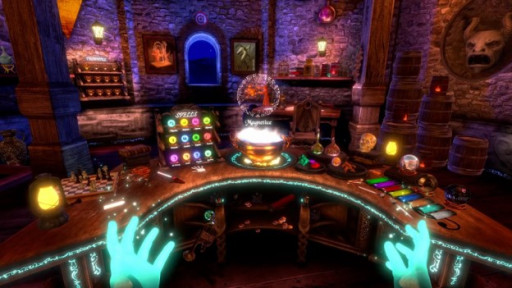
Become a spell-slinging wizard.
Waltz of the Wizard lets you live out your childhood fantasy of casting magic. With hand-tracking support, you'll control spells through different gestures, truly making you feel like a wizard.
With over 10 different powers to try, you'll be snapping, shaking, and waving your hands as you go over the game levels. The sound design is also impressive, making explosions boom and lightning crackle. The best part? Almost everything is interactive through hand tracking alone from picking up random items to creating potions.
Granted, movement takes some getting used to. You'll need to draw a line with your fingers to dictate where your character walks towards. Thankfully, the game features an expansive world full of dungeons, secrets, and treasure to get you acclimated. Oh, and pro tip: the game also features voice commands to aid in the spell-slinging action.
Play this if you like:
- Magic and wonder: The whole point of the game is capturing the feeling of spellcasting, and it succeeds exceptionally! The first time you learn fireball and wreak havoc (of course you will) is just so satisfying. Plus, the added voice commands pull at our smile muscles as you see objects react to your orders.
- Eldritch beings: Spoiler alert: at one point in the game, you get transported into another dimension with these giant creatures looking over you. It’s not fully explained what they are but that just adds to the mystery. Their curious and dismissive personalities don’t trigger any existential crisis, but certainly creates more allure to the world.
- Experimentation, exploration, and discovery: Aside from a couple of hints, the game basically lets you do your own thing. Even creating your spells is left up to you! Essentially, it encourages you to experiment with the game’s tools. For instance, one objective is to pick up the trash in the room. While you can certainly move from place to place, we just used voice commands to bring the garbage towards our character.
- Whimsical companions: While few, the game features a cast of whimsical characters. From a talking skull to the local stranger living in your room, the NPCs ooze with charm and reactivity. You can even cast your spells on them and revive them afterwards if you want to blow some steam.
2. Unplugged

Unplugged is Guitar Hero taken to the next level! In fact, it's even produced by Guitar Hero's lead guitarist, Marcus Henderson, with the specific goal of bringing your air guitar skills to life.
Here, your progress is entirely dependent on your skills. Crowds will cheer the more accurately you play. Do poorly and you're bombarded with rotten fruit. The hand tracking support is simply splendid, forcing you to actually strum and make the notes as you would on a real guitar. You can even do cool poses for bonus points!
With Meta constantly polishing their hand tracking services, Unplugged has never been more immersive. The base game starts with over 20 songs which is then upgradeable to 55--more than enough to be the best air guitarist the world has seen.
Play this if you like:
- A solid soundtrack: While Unplugged’s soundtrack is diverse, it keeps a coherent theme that appeals to a wide audience. From the coolness of Are You Gonna Be My Girl to classics like Should I Stay Or Should I Go, there’s a healthy lineup of songs that makes sure you’ll have fun playing just as much as jamming.
- Testing your reflexes: Unplugged is best played in harder difficulties. While Easy Mode is great to get you used to the controls, they tend to have repetitive strumming sections. The harder tracks are more satisfying, not only having more methodical and varied runs, but also employing real guitar moves like hammer-ons to get you bonus points.
- Playing to the crowd: Like real life bands, you’ll be playing on a simulated stage. Your fans will jam along to your performance and will cheer at the end of the soundtrack. Getting this kind of adoration–especially with Unplugged’s glorious aesthetic–makes you want to play perfectly for the crowd.
1. Rogue Ascent
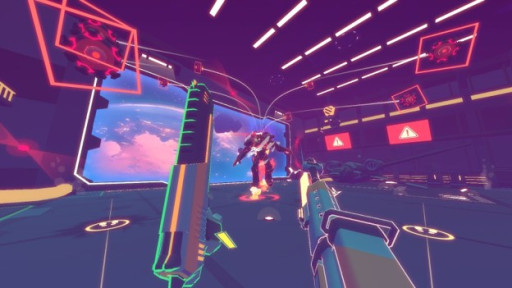
Stop the planet's destruction with finger guns.
Made specifically with Meta's hand-tracking technology in mind, Rogue Ascent has you fighting through a hostile space station--with finger guns! All to save the planet from an impending super laser.
Frankly, the implementation is simply fantastic. From generating shields to movement to shooting, the gestures control like how you'd move in real life. This makes for an extremely immersive gameplay that will hook you for hours on end. Fortunately, with its procedurally generated levels, there will always be something new even after long gaming sessions.
With all that, the graphics, level design, and sound design are nothing to sneeze at either. The comic-like aesthetic lends itself well to the scifi genre, making colors pop and bullets boom. Plus, it can be quite a workout so you can chalk up play time as exercise (wink, wink).
Play this if you like:
- Intense FPS action: The gameplay is fast, fluid, and brutal. Thanks to the simple controls, you can make split-second decisions according to the situation. Enemy squad in front of you? Teleport behind them and decimate with your guns!
- Playing with builds: Like many roguelikes, the game is carried by its arsenal of weapons, powerups, and attachments. These allow you to customize your run to fit your playstyle, whether that's getting up close with a shotgun or firing off nasty headshots with a revolver.
- Killing baddies in style: Rogue Ascent doesn't skimp out on cool points. Reloading, while it's a simple raising of your hands in real life, reflects in-game as rotating the gun between fingers. Your last kill is also played in slow-mo so you can bask in the glory.
Want more VR recommendations? See our other lists below:
- [Top 10] Best VR Exercise Games That Are Fun
- [Top 15] Best VR Adventure Games To Play Right Now
- [Top 15] Best VR Horror Games To Play Right Now
